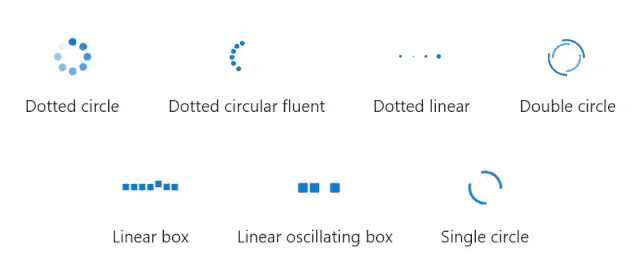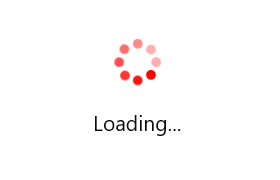


The Busy Indicator control for .NET WinUI is used to display a predefined built-in animation when an operation runs in the background of the application and waiting for its completion. It can be customized in terms of size, color, duration, and content.
Busy indicator includes 7 pre-built animations that can be shown within your applications.

It shows the loading progress of the content and it can be customized with position and template support.

The content indicates the busy status of the control to the users.

The content can be positioned at the top, bottom, right, or left of the indicator.

The content can be customized using the data template.
The .NET WinUI Busy Indicator animation speed can be customized using factor values 0 to 1.

The .NET WinUI Busy Indicator size can be customized using factor values 0 to 1.

The .NET WinUI Busy Indicator color can be customized based on the requirement.

Easily get started with the WinUI BusyIndicator using a few simple lines of XAML and CS code example as demonstrated below.
<Page
x:Class="GettingStarted.MainPage"
xmlns="http://schemas.microsoft.com/winfx/2006/xaml/presentation"
xmlns:x="http://schemas.microsoft.com/winfx/2006/xaml"
xmlns:local="using:GettingStarted"
xmlns:d="http://schemas.microsoft.com/expression/blend/2008"
xmlns:mc="http://schemas.openxmlformats.org/markup-compatibility/2006"
xmlns:notification="using:Syncfusion.UI.Xaml.Notifications"
mc:Ignorable="d"
Background="{ThemeResource ApplicationPageBackgroundThemeBrush}">
<Grid>
<notification:SfBusyIndicator IsActive="True"/>
</Grid>
</Page>// Creating an instance of the BusyIndicator control.
SfBusyIndicator busyIndicator = new SfBusyIndicator();
// Activating the SfBusyIndicator.
busyIndicator.IsActive = true;

Greatness—it’s one thing to say you have it, but it means more when others recognize it. Syncfusion is proud to hold the following industry awards.